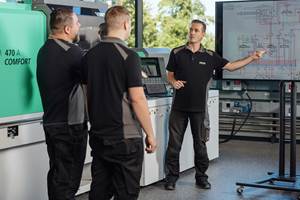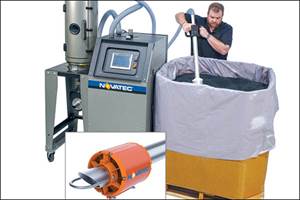Parts Handling Is No Sweat With New Automated packing Systems
Two makers of parts-removal robots recently introduced examples of labor-saving equipment.
High-volume injection molders don’t need to tie up their workers with stacking and packing the continuous cascade of parts flowing out of their molds. They can give their people a breather and let the newest generation of automated devices handle the crush. Two makers of parts-removal robots recently introduced examples of such labor-saving equipment. These include two box-filling machines and some innovative custom solutions for stacking, orienting, and packing.
Fill ’er up
Newly introduced from Japan are a pair of box-filling machines from Yushin America, Inc., Cranston, R.I. Both provide unattended bulk packing of parts. The MI Decker Stocker can store 2-8 hr of production beside the molding machine. The compact, servo-driven system receives parts in a “catcher” beneath the press and delivers them to a good-parts bin, reject bin, or QC sample tray. An exact count of parts is delivered to the good-parts bin, after which a plastic lid is placed on the bin automatically. Finally, a complete shot of good parts is placed automatically in the QC tray on the bin lid. Price is around $28,000.
Also new from Yushin is the ACS-EGS-H Stocker, a tray-filling and handling system that works in conjunction with a robot. The Stocker automatically destacks empty trays, presents them for filling by the robot, and restacks the full trays. It can run unattended for 2-4 hr. Trays can have templates to fixture parts for subsequent automatic operations. It costs about $25,000.
Stack ’em, pack ’em
Three new developments from another maker of high-speed robots represent custom solutions to particular packing needs, but could be of interest to a variety of molders. One introduction from CBW Automation, Fort Collins, Colo., is the CP-2000 automatic case packer for a wide range of containers. Flexibility is its unusual feature: It can pack layers of stacked containers either vertically or horizontally or both in the same box. The stacks arrive in a horizontal position, and the system arranges them into the proper pattern for one layer in the carton. When the array is transferred to the case-packing area, it can be rotated, if necessary, for vertical entry into a box tilted at a 45° angle. The CP-2000 can pack 25 stacks a minute of molded or thermoformed containers.
Also new is the L-2000 dairy-lid unscrambler that can handle the output of a 48-cavity mold for 409-size lids. According to v.p. of sales and marketing Jim Forrester, the need for this device is created by the advent of bigger molds for higher outputs—in this case, 550-600 lids/minute. What’s unusual about this system is its manner of orienting the lids so that they all face the same way for stacking. A photosensor detects whether the lid is facing up or down just before it passes through a spinning tube. This information is relayed via microprocessor controller to a pair of servo-driven “pinch rollers” that are designed to handle the lids as they pass by and impart spin in a clockwise or counterclockwise direction according to their initial orientation. Depending on the direction of lid spin, the rotating “control tube” creates the “righting force” to lift the spinning lid onto its edge in a consistent orientation. The twin servo rollers can reverse direction in as little as 35 millisec. The same photosensor also counts the lids into identical stacks.
Third, a new molding/stacking/packing cell was designed recently by CBW for Medline Industry, Inc., Mundelein, Ill. This cell uses a Husky 330-ton injection machine and a Tradesco 2x32 stack mold to produce 65,800 medicine cups/hr on a 3.5-sec molding cycle. This is twice the previous highest output rate for such a product, according to CBW’s Forrester. The machine runs too fast, and the parts are too light, to permit free-drop ejection, he says. Positive take-out with CBW’s T-193 Slingshot robot takes less than 0.5 sec, faster than the parts could drop free of the mold. And in that same 0.5 sec or less, the robot provides part verification for each cavity with a vacuum transducer, thereby protecting the mold against damage.
The robot stacks the cups in “mini stacks” of 25 cups—a stable height that prevents the vertical stacks from tipping over, Forrester explains. Then the mini stacks are laid down horizontally and combined into full stacks of 100 cups. These stacks are fed to a polyethylene sleever, and five rows of 10 sleeves are inserted one layer at a time into a box. Because the packing tray waits until an entire layer is assembled before inserting it into the box, the system can run “slowly and carefully,” as Forrester puts it. Once a box is full, it indexes out of the filling station and an empty box takes its place automatically.
Related Content
50 Years...600 Issues...and Still Counting
Matt Naitove marks his first half-century in plastics reporting, with a few of his favorite headlines.
Read More50 Years of Headlines … Almost
I was lucky to get an early look at many of the past half-century’s exciting developments in plastics. Here’s a selection.
Read MoreFive Ways to Increase Productivity for Injection Molders
Faster setups, automation tools and proper training and support can go a long way.
Read MoreNew Technology Enables ‘Smart Drying’ Based on Resin Moisture
The ‘DryerGenie’ marries drying technology and input moisture measurement with a goal to putting an end to drying based on time.
Read MoreRead Next
Advanced Recycling: Beyond Pyrolysis
Consumer-product brand owners increasingly see advanced chemical recycling as a necessary complement to mechanical recycling if they are to meet ambitious goals for a circular economy in the next decade. Dozens of technology providers are developing new technologies to overcome the limitations of existing pyrolysis methods and to commercialize various alternative approaches to chemical recycling of plastics.
Read MoreLead the Conversation, Change the Conversation
Coverage of single-use plastics can be both misleading and demoralizing. Here are 10 tips for changing the perception of the plastics industry at your company and in your community.
Read MoreProcessor Turns to AI to Help Keep Machines Humming
At captive processor McConkey, a new generation of artificial intelligence models, highlighted by ChatGPT, is helping it wade through the shortage of skilled labor and keep its production lines churning out good parts.
Read More












.png;maxWidth=300;quality=90)












